Business Environment Analysis Report: Nestle Corporation
VerifiedAdded on 2020/06/06
|12
|3687
|85
Report
AI Summary
This report presents a comprehensive analysis of Nestle's business environment. It begins with an introduction to the business environment and its components, including macro and micro factors. The report then delves into the organizational structure of Nestle, detailing the functions and relationships of various departments such as administration, research and production, human resources, sales and marketing, accounting, and finance. A PESTLE analysis is conducted to evaluate the impact of political, economic, socio-cultural, technological, legal, and environmental factors on Nestle's operations. Furthermore, the report examines the micro environment through a SWOT analysis, identifying Nestle's strengths, weaknesses, opportunities, and threats. The analysis considers the effects of suppliers, customers, and competitors. The report concludes by summarizing the key findings and implications of the business environment analysis for Nestle's strategic decision-making and future prospects. This report is designed to provide students with a detailed understanding of business environment analysis using Nestle as a case study.
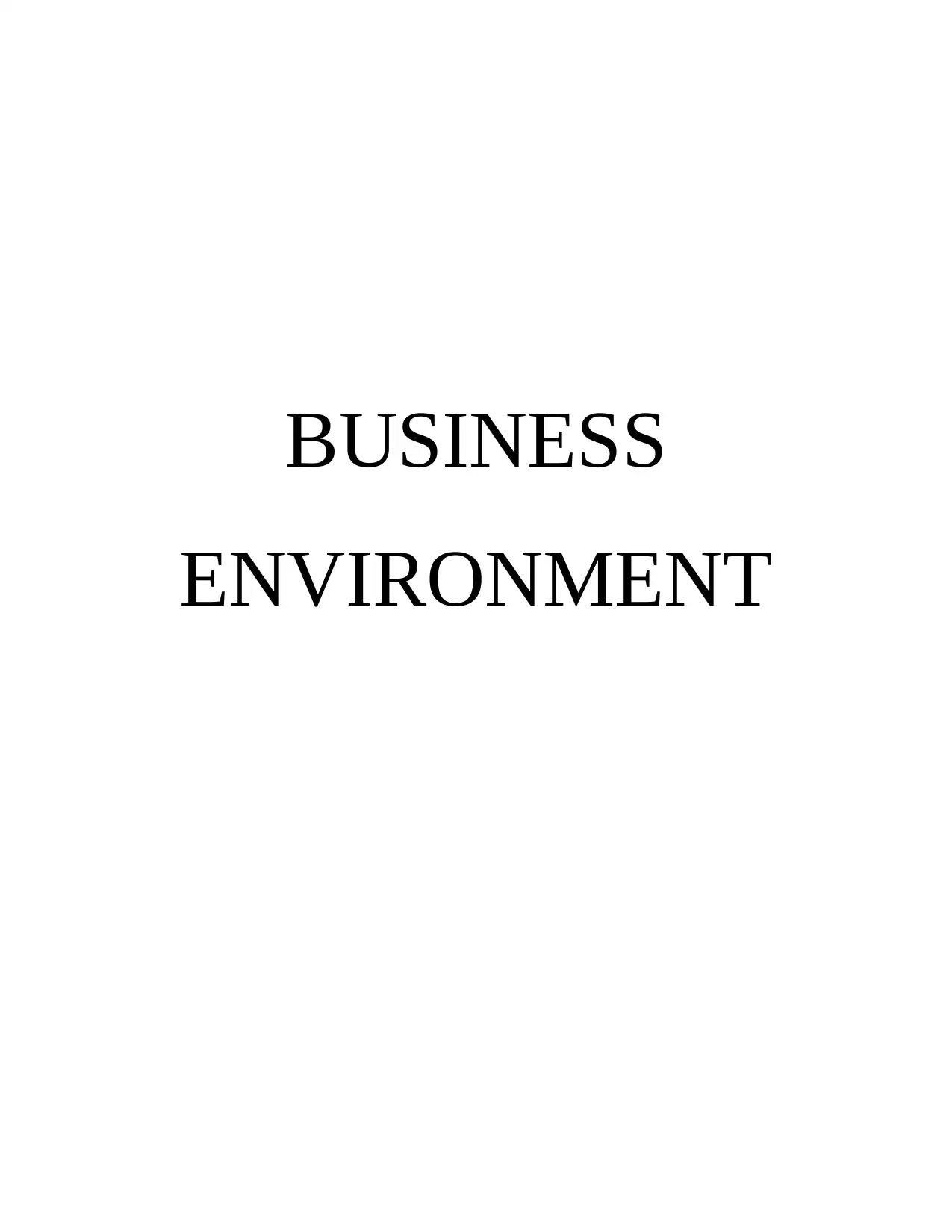
BUSINESS
ENVIRONMENT
ENVIRONMENT
Paraphrase This Document
Need a fresh take? Get an instant paraphrase of this document with our AI Paraphraser
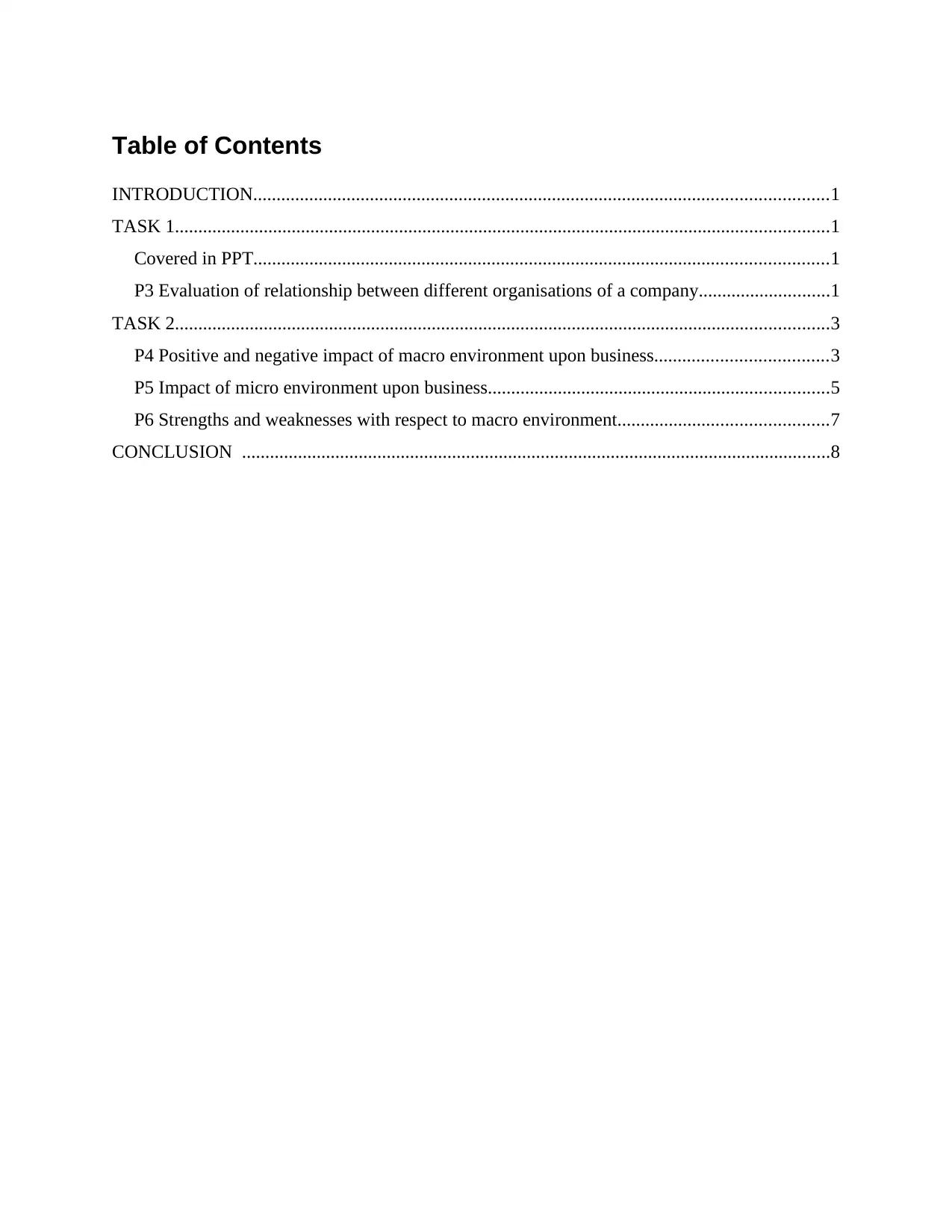
Table of Contents
INTRODUCTION...........................................................................................................................1
TASK 1............................................................................................................................................1
Covered in PPT...........................................................................................................................1
P3 Evaluation of relationship between different organisations of a company............................1
TASK 2............................................................................................................................................3
P4 Positive and negative impact of macro environment upon business.....................................3
P5 Impact of micro environment upon business.........................................................................5
P6 Strengths and weaknesses with respect to macro environment.............................................7
CONCLUSION ..............................................................................................................................8
INTRODUCTION...........................................................................................................................1
TASK 1............................................................................................................................................1
Covered in PPT...........................................................................................................................1
P3 Evaluation of relationship between different organisations of a company............................1
TASK 2............................................................................................................................................3
P4 Positive and negative impact of macro environment upon business.....................................3
P5 Impact of micro environment upon business.........................................................................5
P6 Strengths and weaknesses with respect to macro environment.............................................7
CONCLUSION ..............................................................................................................................8
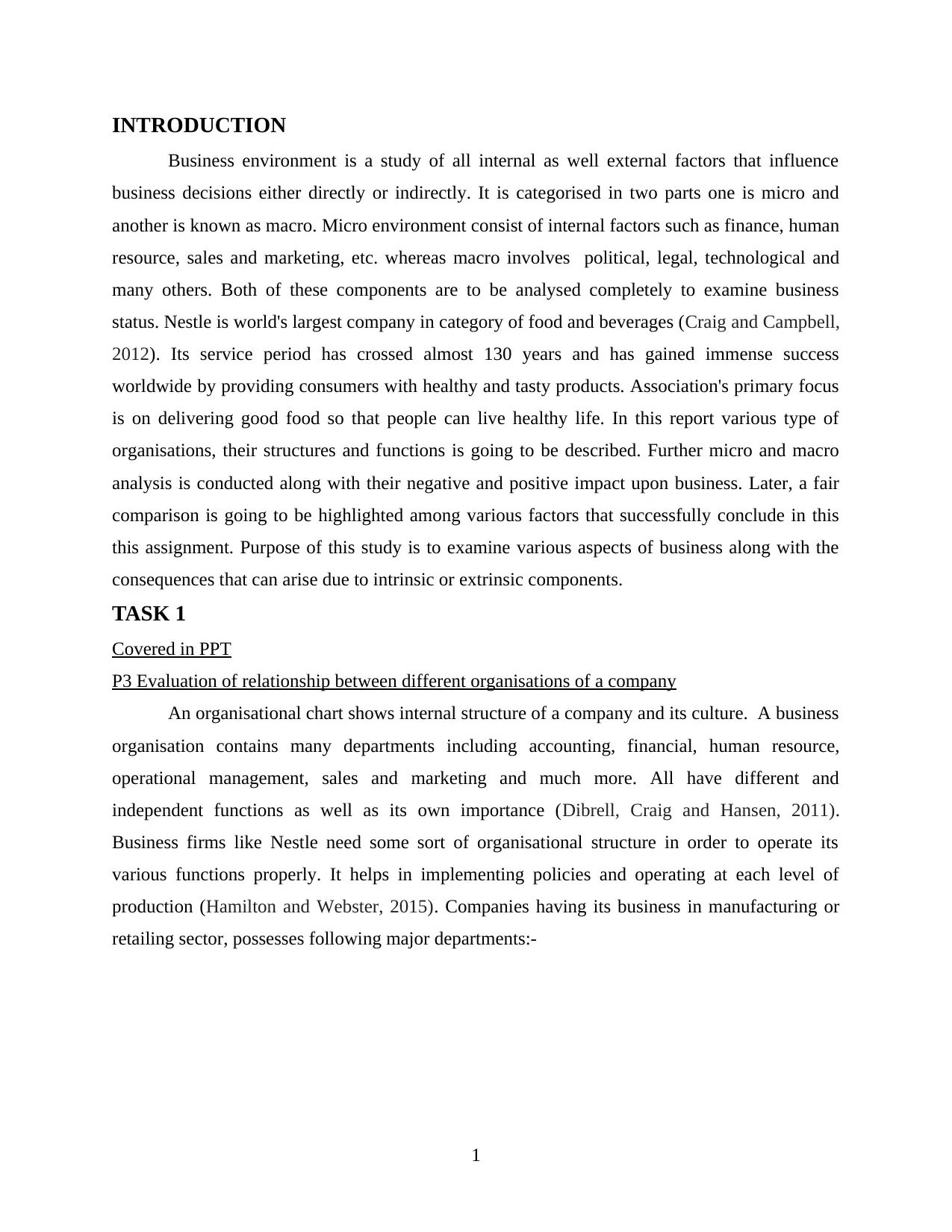
INTRODUCTION
Business environment is a study of all internal as well external factors that influence
business decisions either directly or indirectly. It is categorised in two parts one is micro and
another is known as macro. Micro environment consist of internal factors such as finance, human
resource, sales and marketing, etc. whereas macro involves political, legal, technological and
many others. Both of these components are to be analysed completely to examine business
status. Nestle is world's largest company in category of food and beverages (Craig and Campbell,
2012). Its service period has crossed almost 130 years and has gained immense success
worldwide by providing consumers with healthy and tasty products. Association's primary focus
is on delivering good food so that people can live healthy life. In this report various type of
organisations, their structures and functions is going to be described. Further micro and macro
analysis is conducted along with their negative and positive impact upon business. Later, a fair
comparison is going to be highlighted among various factors that successfully conclude in this
this assignment. Purpose of this study is to examine various aspects of business along with the
consequences that can arise due to intrinsic or extrinsic components.
TASK 1
Covered in PPT
P3 Evaluation of relationship between different organisations of a company
An organisational chart shows internal structure of a company and its culture. A business
organisation contains many departments including accounting, financial, human resource,
operational management, sales and marketing and much more. All have different and
independent functions as well as its own importance (Dibrell, Craig and Hansen, 2011).
Business firms like Nestle need some sort of organisational structure in order to operate its
various functions properly. It helps in implementing policies and operating at each level of
production (Hamilton and Webster, 2015). Companies having its business in manufacturing or
retailing sector, possesses following major departments:-
1
Business environment is a study of all internal as well external factors that influence
business decisions either directly or indirectly. It is categorised in two parts one is micro and
another is known as macro. Micro environment consist of internal factors such as finance, human
resource, sales and marketing, etc. whereas macro involves political, legal, technological and
many others. Both of these components are to be analysed completely to examine business
status. Nestle is world's largest company in category of food and beverages (Craig and Campbell,
2012). Its service period has crossed almost 130 years and has gained immense success
worldwide by providing consumers with healthy and tasty products. Association's primary focus
is on delivering good food so that people can live healthy life. In this report various type of
organisations, their structures and functions is going to be described. Further micro and macro
analysis is conducted along with their negative and positive impact upon business. Later, a fair
comparison is going to be highlighted among various factors that successfully conclude in this
this assignment. Purpose of this study is to examine various aspects of business along with the
consequences that can arise due to intrinsic or extrinsic components.
TASK 1
Covered in PPT
P3 Evaluation of relationship between different organisations of a company
An organisational chart shows internal structure of a company and its culture. A business
organisation contains many departments including accounting, financial, human resource,
operational management, sales and marketing and much more. All have different and
independent functions as well as its own importance (Dibrell, Craig and Hansen, 2011).
Business firms like Nestle need some sort of organisational structure in order to operate its
various functions properly. It helps in implementing policies and operating at each level of
production (Hamilton and Webster, 2015). Companies having its business in manufacturing or
retailing sector, possesses following major departments:-
1
⊘ This is a preview!⊘
Do you want full access?
Subscribe today to unlock all pages.

Trusted by 1+ million students worldwide
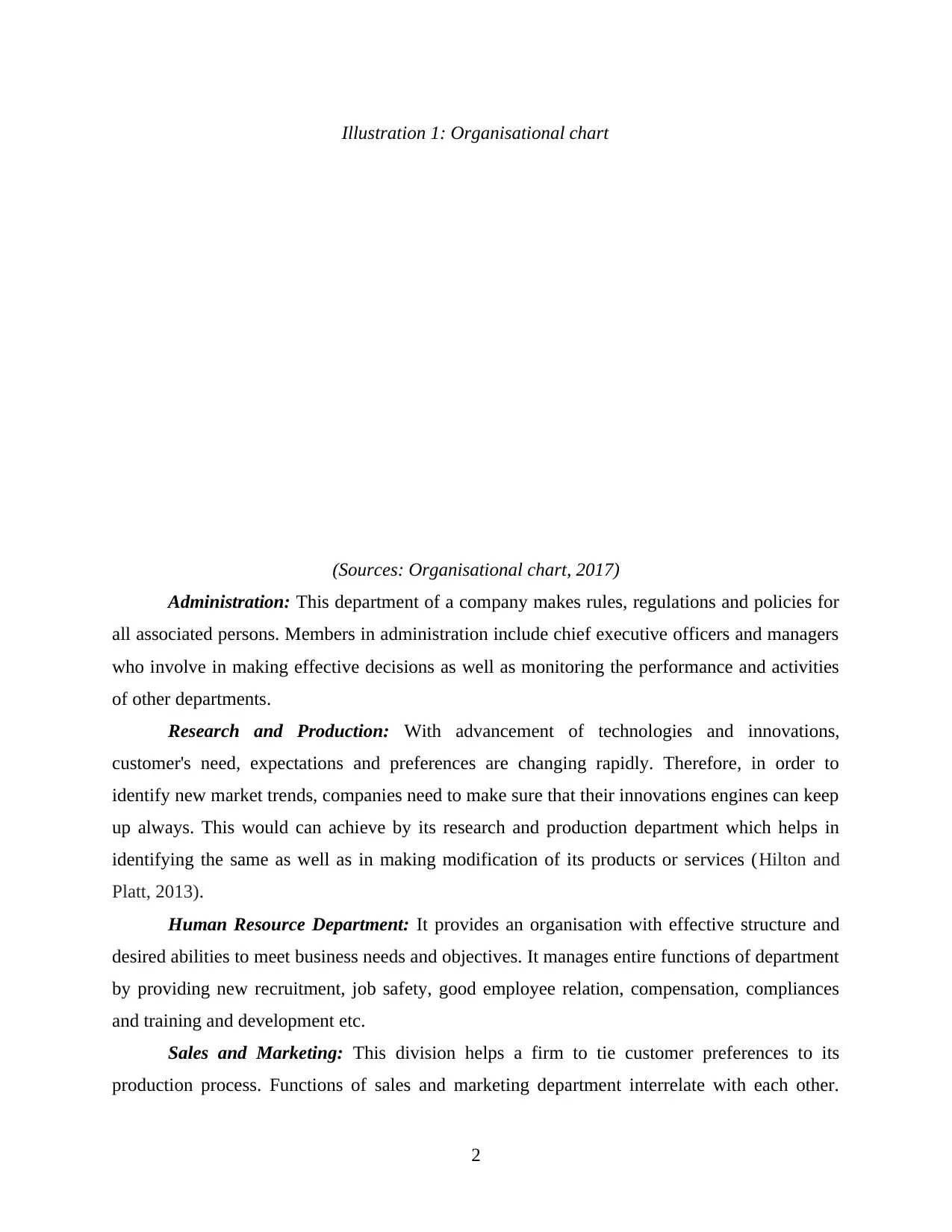
Illustration 1: Organisational chart
(Sources: Organisational chart, 2017)
Administration: This department of a company makes rules, regulations and policies for
all associated persons. Members in administration include chief executive officers and managers
who involve in making effective decisions as well as monitoring the performance and activities
of other departments.
Research and Production: With advancement of technologies and innovations,
customer's need, expectations and preferences are changing rapidly. Therefore, in order to
identify new market trends, companies need to make sure that their innovations engines can keep
up always. This would can achieve by its research and production department which helps in
identifying the same as well as in making modification of its products or services (Hilton and
Platt, 2013).
Human Resource Department: It provides an organisation with effective structure and
desired abilities to meet business needs and objectives. It manages entire functions of department
by providing new recruitment, job safety, good employee relation, compensation, compliances
and training and development etc.
Sales and Marketing: This division helps a firm to tie customer preferences to its
production process. Functions of sales and marketing department interrelate with each other.
2
(Sources: Organisational chart, 2017)
Administration: This department of a company makes rules, regulations and policies for
all associated persons. Members in administration include chief executive officers and managers
who involve in making effective decisions as well as monitoring the performance and activities
of other departments.
Research and Production: With advancement of technologies and innovations,
customer's need, expectations and preferences are changing rapidly. Therefore, in order to
identify new market trends, companies need to make sure that their innovations engines can keep
up always. This would can achieve by its research and production department which helps in
identifying the same as well as in making modification of its products or services (Hilton and
Platt, 2013).
Human Resource Department: It provides an organisation with effective structure and
desired abilities to meet business needs and objectives. It manages entire functions of department
by providing new recruitment, job safety, good employee relation, compensation, compliances
and training and development etc.
Sales and Marketing: This division helps a firm to tie customer preferences to its
production process. Functions of sales and marketing department interrelate with each other.
2
Paraphrase This Document
Need a fresh take? Get an instant paraphrase of this document with our AI Paraphraser
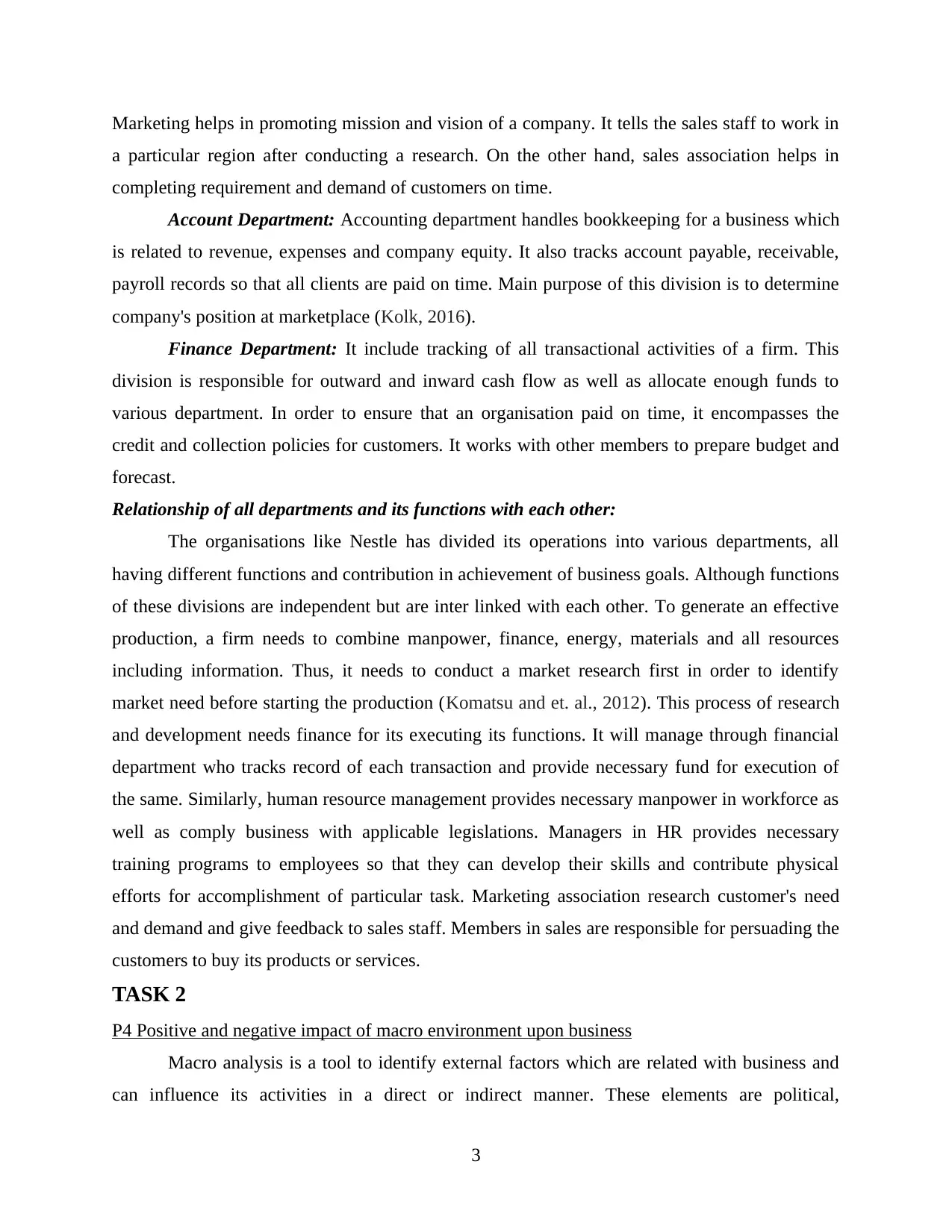
Marketing helps in promoting mission and vision of a company. It tells the sales staff to work in
a particular region after conducting a research. On the other hand, sales association helps in
completing requirement and demand of customers on time.
Account Department: Accounting department handles bookkeeping for a business which
is related to revenue, expenses and company equity. It also tracks account payable, receivable,
payroll records so that all clients are paid on time. Main purpose of this division is to determine
company's position at marketplace (Kolk, 2016).
Finance Department: It include tracking of all transactional activities of a firm. This
division is responsible for outward and inward cash flow as well as allocate enough funds to
various department. In order to ensure that an organisation paid on time, it encompasses the
credit and collection policies for customers. It works with other members to prepare budget and
forecast.
Relationship of all departments and its functions with each other:
The organisations like Nestle has divided its operations into various departments, all
having different functions and contribution in achievement of business goals. Although functions
of these divisions are independent but are inter linked with each other. To generate an effective
production, a firm needs to combine manpower, finance, energy, materials and all resources
including information. Thus, it needs to conduct a market research first in order to identify
market need before starting the production (Komatsu and et. al., 2012). This process of research
and development needs finance for its executing its functions. It will manage through financial
department who tracks record of each transaction and provide necessary fund for execution of
the same. Similarly, human resource management provides necessary manpower in workforce as
well as comply business with applicable legislations. Managers in HR provides necessary
training programs to employees so that they can develop their skills and contribute physical
efforts for accomplishment of particular task. Marketing association research customer's need
and demand and give feedback to sales staff. Members in sales are responsible for persuading the
customers to buy its products or services.
TASK 2
P4 Positive and negative impact of macro environment upon business
Macro analysis is a tool to identify external factors which are related with business and
can influence its activities in a direct or indirect manner. These elements are political,
3
a particular region after conducting a research. On the other hand, sales association helps in
completing requirement and demand of customers on time.
Account Department: Accounting department handles bookkeeping for a business which
is related to revenue, expenses and company equity. It also tracks account payable, receivable,
payroll records so that all clients are paid on time. Main purpose of this division is to determine
company's position at marketplace (Kolk, 2016).
Finance Department: It include tracking of all transactional activities of a firm. This
division is responsible for outward and inward cash flow as well as allocate enough funds to
various department. In order to ensure that an organisation paid on time, it encompasses the
credit and collection policies for customers. It works with other members to prepare budget and
forecast.
Relationship of all departments and its functions with each other:
The organisations like Nestle has divided its operations into various departments, all
having different functions and contribution in achievement of business goals. Although functions
of these divisions are independent but are inter linked with each other. To generate an effective
production, a firm needs to combine manpower, finance, energy, materials and all resources
including information. Thus, it needs to conduct a market research first in order to identify
market need before starting the production (Komatsu and et. al., 2012). This process of research
and development needs finance for its executing its functions. It will manage through financial
department who tracks record of each transaction and provide necessary fund for execution of
the same. Similarly, human resource management provides necessary manpower in workforce as
well as comply business with applicable legislations. Managers in HR provides necessary
training programs to employees so that they can develop their skills and contribute physical
efforts for accomplishment of particular task. Marketing association research customer's need
and demand and give feedback to sales staff. Members in sales are responsible for persuading the
customers to buy its products or services.
TASK 2
P4 Positive and negative impact of macro environment upon business
Macro analysis is a tool to identify external factors which are related with business and
can influence its activities in a direct or indirect manner. These elements are political,
3
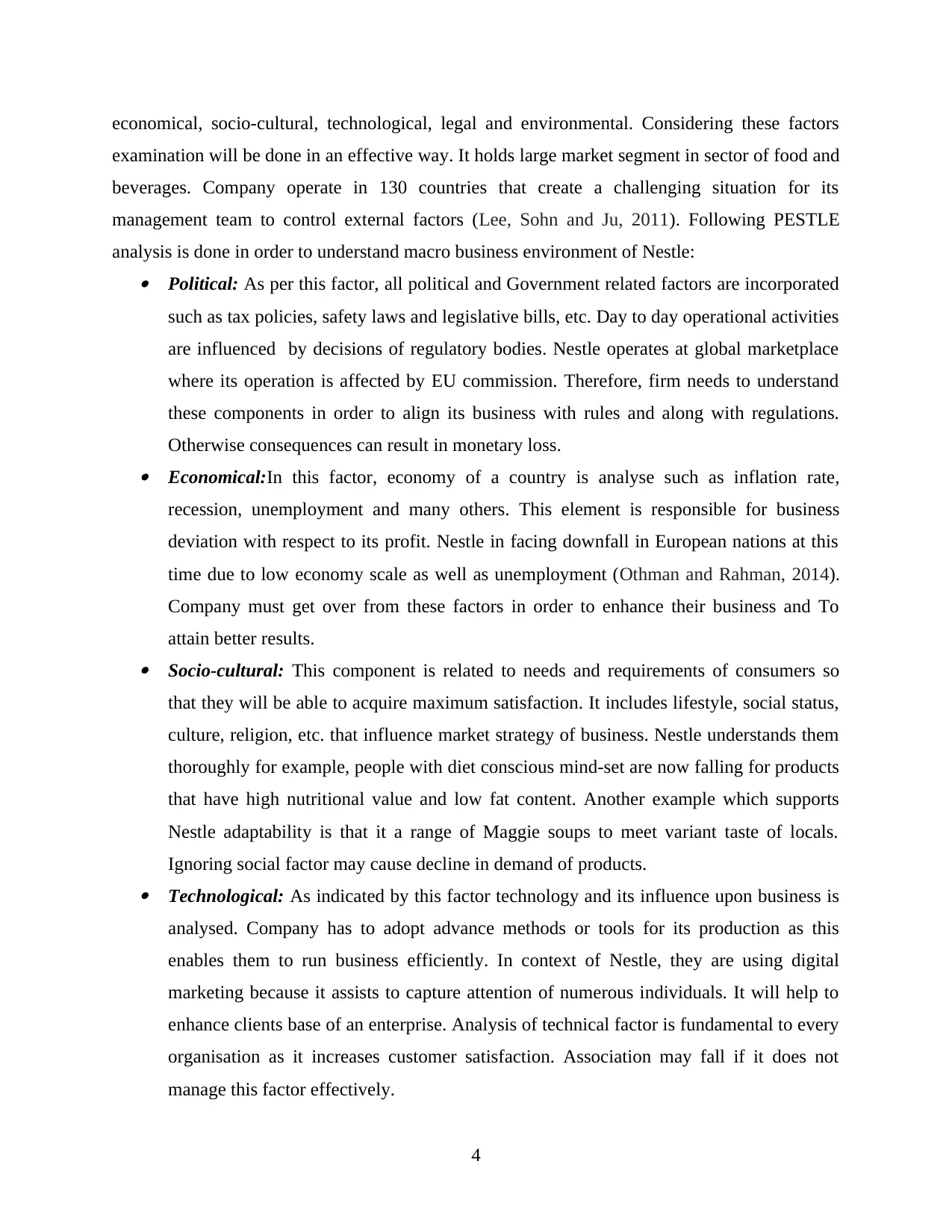
economical, socio-cultural, technological, legal and environmental. Considering these factors
examination will be done in an effective way. It holds large market segment in sector of food and
beverages. Company operate in 130 countries that create a challenging situation for its
management team to control external factors (Lee, Sohn and Ju, 2011). Following PESTLE
analysis is done in order to understand macro business environment of Nestle: Political: As per this factor, all political and Government related factors are incorporated
such as tax policies, safety laws and legislative bills, etc. Day to day operational activities
are influenced by decisions of regulatory bodies. Nestle operates at global marketplace
where its operation is affected by EU commission. Therefore, firm needs to understand
these components in order to align its business with rules and along with regulations.
Otherwise consequences can result in monetary loss. Economical:In this factor, economy of a country is analyse such as inflation rate,
recession, unemployment and many others. This element is responsible for business
deviation with respect to its profit. Nestle in facing downfall in European nations at this
time due to low economy scale as well as unemployment (Othman and Rahman, 2014).
Company must get over from these factors in order to enhance their business and To
attain better results. Socio-cultural: This component is related to needs and requirements of consumers so
that they will be able to acquire maximum satisfaction. It includes lifestyle, social status,
culture, religion, etc. that influence market strategy of business. Nestle understands them
thoroughly for example, people with diet conscious mind-set are now falling for products
that have high nutritional value and low fat content. Another example which supports
Nestle adaptability is that it a range of Maggie soups to meet variant taste of locals.
Ignoring social factor may cause decline in demand of products. Technological: As indicated by this factor technology and its influence upon business is
analysed. Company has to adopt advance methods or tools for its production as this
enables them to run business efficiently. In context of Nestle, they are using digital
marketing because it assists to capture attention of numerous individuals. It will help to
enhance clients base of an enterprise. Analysis of technical factor is fundamental to every
organisation as it increases customer satisfaction. Association may fall if it does not
manage this factor effectively.
4
examination will be done in an effective way. It holds large market segment in sector of food and
beverages. Company operate in 130 countries that create a challenging situation for its
management team to control external factors (Lee, Sohn and Ju, 2011). Following PESTLE
analysis is done in order to understand macro business environment of Nestle: Political: As per this factor, all political and Government related factors are incorporated
such as tax policies, safety laws and legislative bills, etc. Day to day operational activities
are influenced by decisions of regulatory bodies. Nestle operates at global marketplace
where its operation is affected by EU commission. Therefore, firm needs to understand
these components in order to align its business with rules and along with regulations.
Otherwise consequences can result in monetary loss. Economical:In this factor, economy of a country is analyse such as inflation rate,
recession, unemployment and many others. This element is responsible for business
deviation with respect to its profit. Nestle in facing downfall in European nations at this
time due to low economy scale as well as unemployment (Othman and Rahman, 2014).
Company must get over from these factors in order to enhance their business and To
attain better results. Socio-cultural: This component is related to needs and requirements of consumers so
that they will be able to acquire maximum satisfaction. It includes lifestyle, social status,
culture, religion, etc. that influence market strategy of business. Nestle understands them
thoroughly for example, people with diet conscious mind-set are now falling for products
that have high nutritional value and low fat content. Another example which supports
Nestle adaptability is that it a range of Maggie soups to meet variant taste of locals.
Ignoring social factor may cause decline in demand of products. Technological: As indicated by this factor technology and its influence upon business is
analysed. Company has to adopt advance methods or tools for its production as this
enables them to run business efficiently. In context of Nestle, they are using digital
marketing because it assists to capture attention of numerous individuals. It will help to
enhance clients base of an enterprise. Analysis of technical factor is fundamental to every
organisation as it increases customer satisfaction. Association may fall if it does not
manage this factor effectively.
4
⊘ This is a preview!⊘
Do you want full access?
Subscribe today to unlock all pages.

Trusted by 1+ million students worldwide
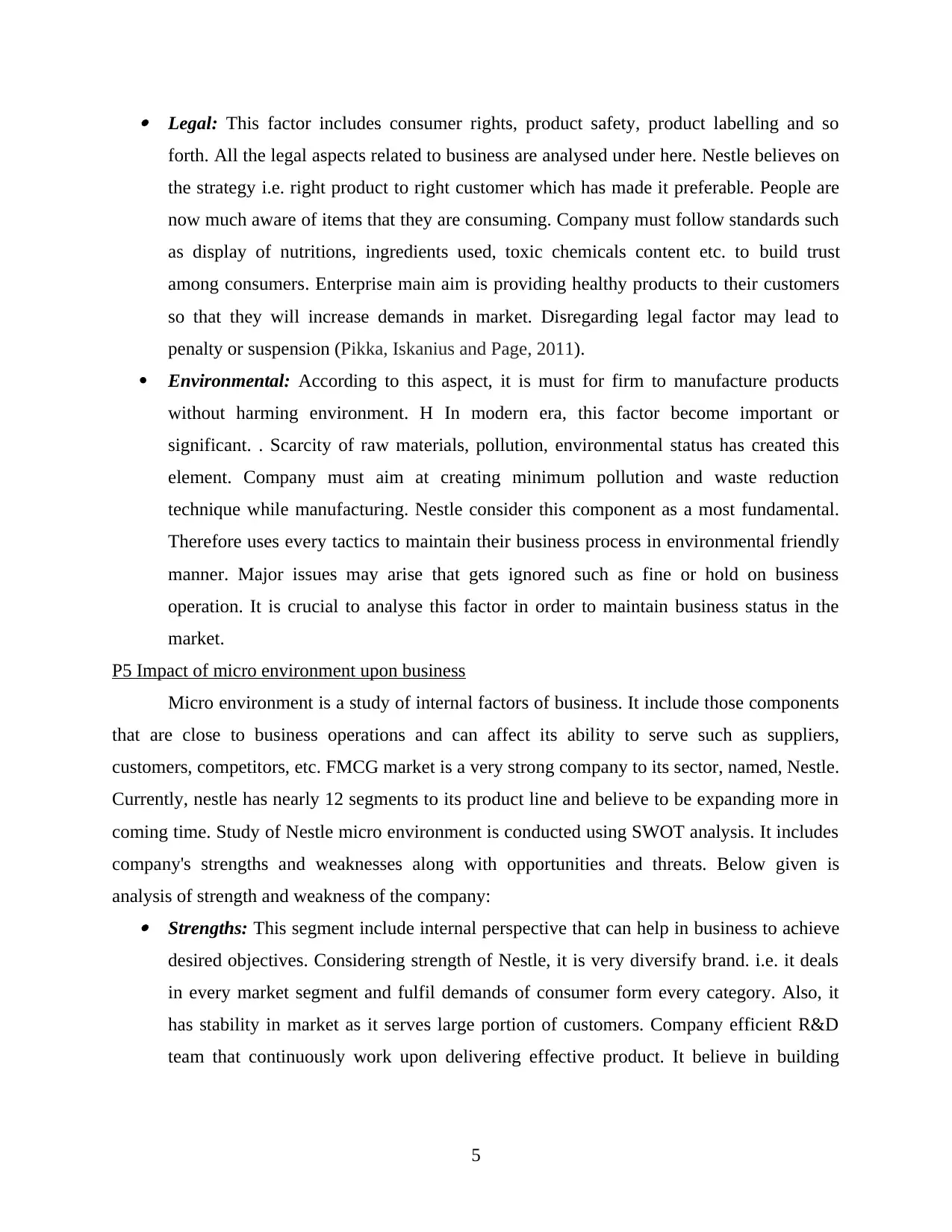
Legal: This factor includes consumer rights, product safety, product labelling and so
forth. All the legal aspects related to business are analysed under here. Nestle believes on
the strategy i.e. right product to right customer which has made it preferable. People are
now much aware of items that they are consuming. Company must follow standards such
as display of nutritions, ingredients used, toxic chemicals content etc. to build trust
among consumers. Enterprise main aim is providing healthy products to their customers
so that they will increase demands in market. Disregarding legal factor may lead to
penalty or suspension (Pikka, Iskanius and Page, 2011).
Environmental: According to this aspect, it is must for firm to manufacture products
without harming environment. H In modern era, this factor become important or
significant. . Scarcity of raw materials, pollution, environmental status has created this
element. Company must aim at creating minimum pollution and waste reduction
technique while manufacturing. Nestle consider this component as a most fundamental.
Therefore uses every tactics to maintain their business process in environmental friendly
manner. Major issues may arise that gets ignored such as fine or hold on business
operation. It is crucial to analyse this factor in order to maintain business status in the
market.
P5 Impact of micro environment upon business
Micro environment is a study of internal factors of business. It include those components
that are close to business operations and can affect its ability to serve such as suppliers,
customers, competitors, etc. FMCG market is a very strong company to its sector, named, Nestle.
Currently, nestle has nearly 12 segments to its product line and believe to be expanding more in
coming time. Study of Nestle micro environment is conducted using SWOT analysis. It includes
company's strengths and weaknesses along with opportunities and threats. Below given is
analysis of strength and weakness of the company: Strengths: This segment include internal perspective that can help in business to achieve
desired objectives. Considering strength of Nestle, it is very diversify brand. i.e. it deals
in every market segment and fulfil demands of consumer form every category. Also, it
has stability in market as it serves large portion of customers. Company efficient R&D
team that continuously work upon delivering effective product. It believe in building
5
forth. All the legal aspects related to business are analysed under here. Nestle believes on
the strategy i.e. right product to right customer which has made it preferable. People are
now much aware of items that they are consuming. Company must follow standards such
as display of nutritions, ingredients used, toxic chemicals content etc. to build trust
among consumers. Enterprise main aim is providing healthy products to their customers
so that they will increase demands in market. Disregarding legal factor may lead to
penalty or suspension (Pikka, Iskanius and Page, 2011).
Environmental: According to this aspect, it is must for firm to manufacture products
without harming environment. H In modern era, this factor become important or
significant. . Scarcity of raw materials, pollution, environmental status has created this
element. Company must aim at creating minimum pollution and waste reduction
technique while manufacturing. Nestle consider this component as a most fundamental.
Therefore uses every tactics to maintain their business process in environmental friendly
manner. Major issues may arise that gets ignored such as fine or hold on business
operation. It is crucial to analyse this factor in order to maintain business status in the
market.
P5 Impact of micro environment upon business
Micro environment is a study of internal factors of business. It include those components
that are close to business operations and can affect its ability to serve such as suppliers,
customers, competitors, etc. FMCG market is a very strong company to its sector, named, Nestle.
Currently, nestle has nearly 12 segments to its product line and believe to be expanding more in
coming time. Study of Nestle micro environment is conducted using SWOT analysis. It includes
company's strengths and weaknesses along with opportunities and threats. Below given is
analysis of strength and weakness of the company: Strengths: This segment include internal perspective that can help in business to achieve
desired objectives. Considering strength of Nestle, it is very diversify brand. i.e. it deals
in every market segment and fulfil demands of consumer form every category. Also, it
has stability in market as it serves large portion of customers. Company efficient R&D
team that continuously work upon delivering effective product. It believe in building
5
Paraphrase This Document
Need a fresh take? Get an instant paraphrase of this document with our AI Paraphraser
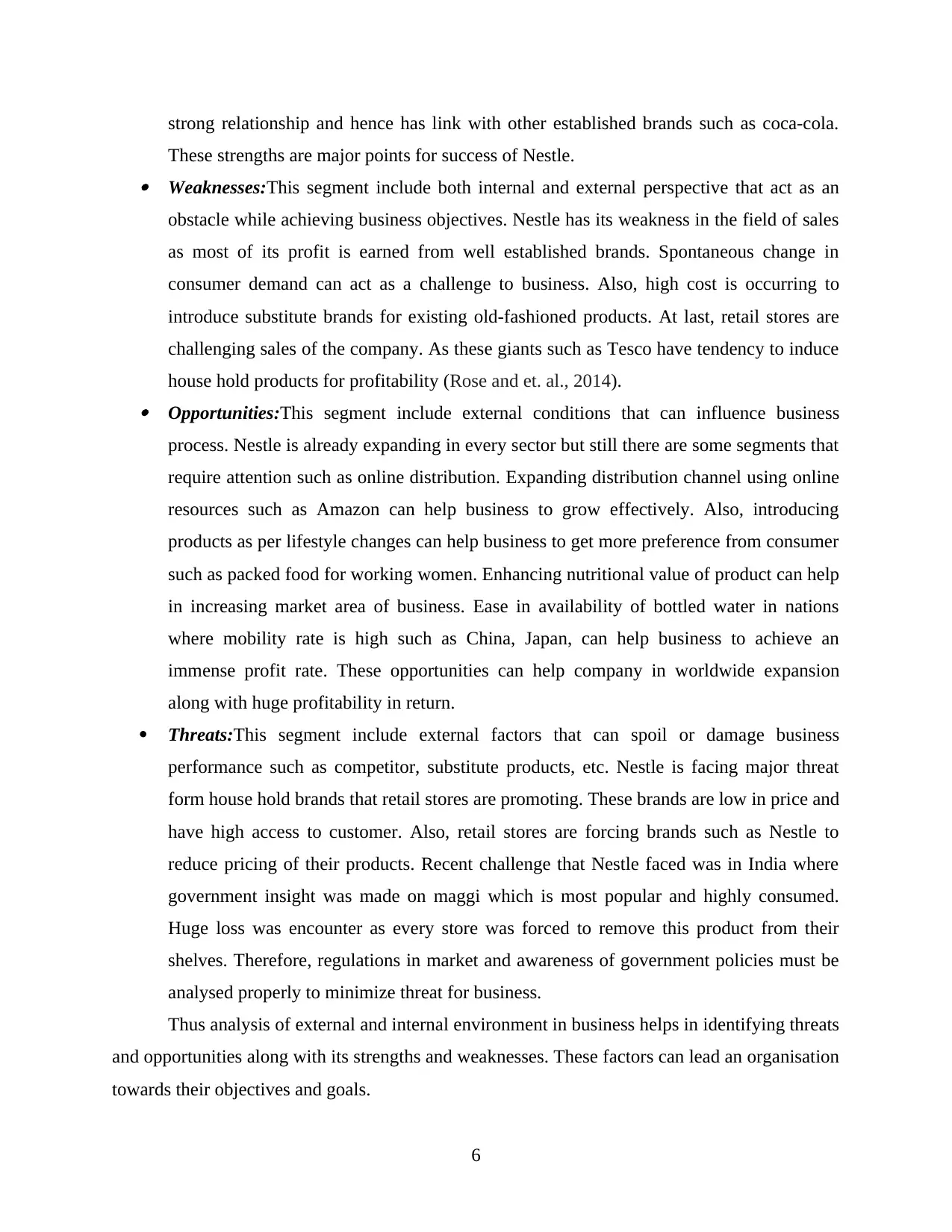
strong relationship and hence has link with other established brands such as coca-cola.
These strengths are major points for success of Nestle. Weaknesses:This segment include both internal and external perspective that act as an
obstacle while achieving business objectives. Nestle has its weakness in the field of sales
as most of its profit is earned from well established brands. Spontaneous change in
consumer demand can act as a challenge to business. Also, high cost is occurring to
introduce substitute brands for existing old-fashioned products. At last, retail stores are
challenging sales of the company. As these giants such as Tesco have tendency to induce
house hold products for profitability (Rose and et. al., 2014). Opportunities:This segment include external conditions that can influence business
process. Nestle is already expanding in every sector but still there are some segments that
require attention such as online distribution. Expanding distribution channel using online
resources such as Amazon can help business to grow effectively. Also, introducing
products as per lifestyle changes can help business to get more preference from consumer
such as packed food for working women. Enhancing nutritional value of product can help
in increasing market area of business. Ease in availability of bottled water in nations
where mobility rate is high such as China, Japan, can help business to achieve an
immense profit rate. These opportunities can help company in worldwide expansion
along with huge profitability in return.
Threats:This segment include external factors that can spoil or damage business
performance such as competitor, substitute products, etc. Nestle is facing major threat
form house hold brands that retail stores are promoting. These brands are low in price and
have high access to customer. Also, retail stores are forcing brands such as Nestle to
reduce pricing of their products. Recent challenge that Nestle faced was in India where
government insight was made on maggi which is most popular and highly consumed.
Huge loss was encounter as every store was forced to remove this product from their
shelves. Therefore, regulations in market and awareness of government policies must be
analysed properly to minimize threat for business.
Thus analysis of external and internal environment in business helps in identifying threats
and opportunities along with its strengths and weaknesses. These factors can lead an organisation
towards their objectives and goals.
6
These strengths are major points for success of Nestle. Weaknesses:This segment include both internal and external perspective that act as an
obstacle while achieving business objectives. Nestle has its weakness in the field of sales
as most of its profit is earned from well established brands. Spontaneous change in
consumer demand can act as a challenge to business. Also, high cost is occurring to
introduce substitute brands for existing old-fashioned products. At last, retail stores are
challenging sales of the company. As these giants such as Tesco have tendency to induce
house hold products for profitability (Rose and et. al., 2014). Opportunities:This segment include external conditions that can influence business
process. Nestle is already expanding in every sector but still there are some segments that
require attention such as online distribution. Expanding distribution channel using online
resources such as Amazon can help business to grow effectively. Also, introducing
products as per lifestyle changes can help business to get more preference from consumer
such as packed food for working women. Enhancing nutritional value of product can help
in increasing market area of business. Ease in availability of bottled water in nations
where mobility rate is high such as China, Japan, can help business to achieve an
immense profit rate. These opportunities can help company in worldwide expansion
along with huge profitability in return.
Threats:This segment include external factors that can spoil or damage business
performance such as competitor, substitute products, etc. Nestle is facing major threat
form house hold brands that retail stores are promoting. These brands are low in price and
have high access to customer. Also, retail stores are forcing brands such as Nestle to
reduce pricing of their products. Recent challenge that Nestle faced was in India where
government insight was made on maggi which is most popular and highly consumed.
Huge loss was encounter as every store was forced to remove this product from their
shelves. Therefore, regulations in market and awareness of government policies must be
analysed properly to minimize threat for business.
Thus analysis of external and internal environment in business helps in identifying threats
and opportunities along with its strengths and weaknesses. These factors can lead an organisation
towards their objectives and goals.
6
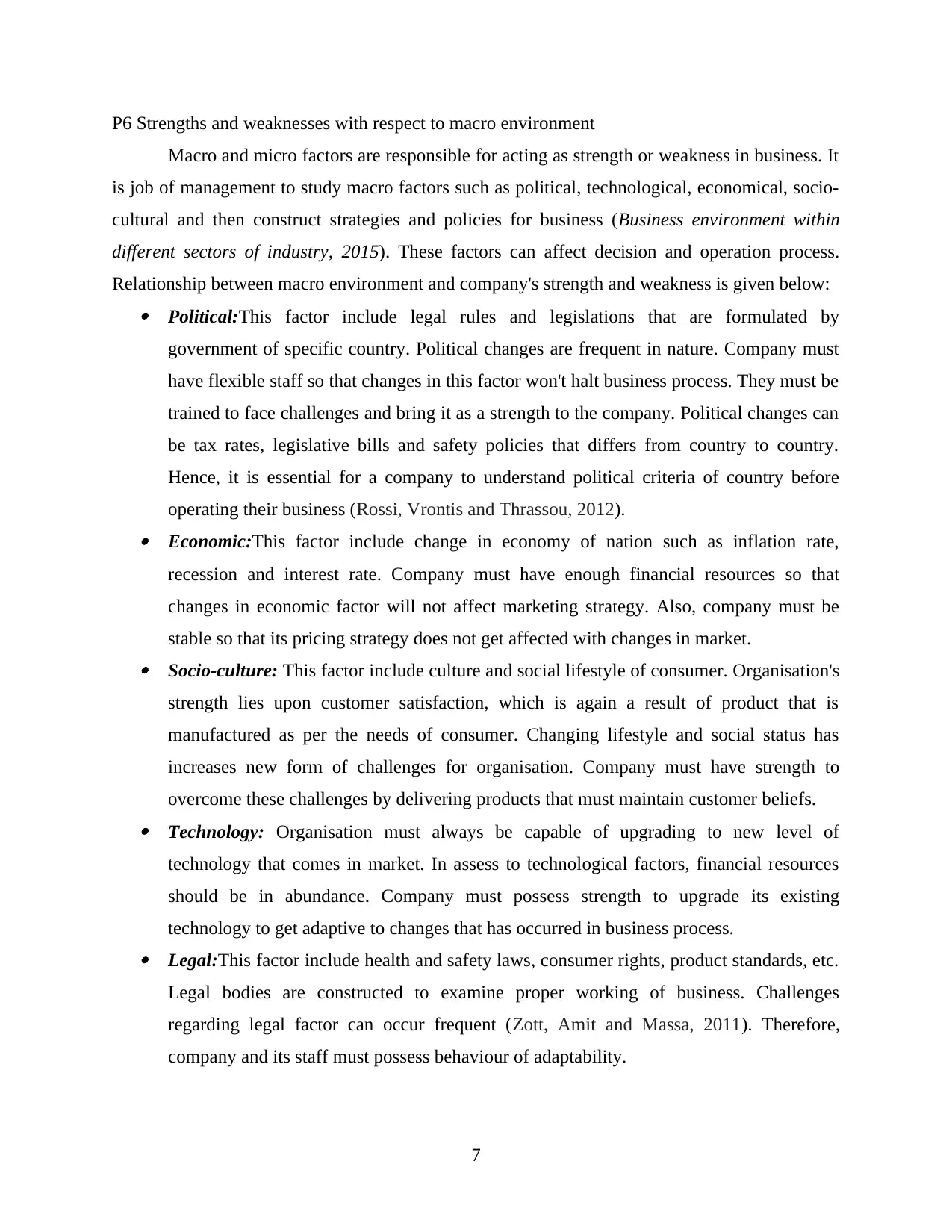
P6 Strengths and weaknesses with respect to macro environment
Macro and micro factors are responsible for acting as strength or weakness in business. It
is job of management to study macro factors such as political, technological, economical, socio-
cultural and then construct strategies and policies for business (Business environment within
different sectors of industry, 2015). These factors can affect decision and operation process.
Relationship between macro environment and company's strength and weakness is given below: Political:This factor include legal rules and legislations that are formulated by
government of specific country. Political changes are frequent in nature. Company must
have flexible staff so that changes in this factor won't halt business process. They must be
trained to face challenges and bring it as a strength to the company. Political changes can
be tax rates, legislative bills and safety policies that differs from country to country.
Hence, it is essential for a company to understand political criteria of country before
operating their business (Rossi, Vrontis and Thrassou, 2012). Economic:This factor include change in economy of nation such as inflation rate,
recession and interest rate. Company must have enough financial resources so that
changes in economic factor will not affect marketing strategy. Also, company must be
stable so that its pricing strategy does not get affected with changes in market. Socio-culture: This factor include culture and social lifestyle of consumer. Organisation's
strength lies upon customer satisfaction, which is again a result of product that is
manufactured as per the needs of consumer. Changing lifestyle and social status has
increases new form of challenges for organisation. Company must have strength to
overcome these challenges by delivering products that must maintain customer beliefs. Technology: Organisation must always be capable of upgrading to new level of
technology that comes in market. In assess to technological factors, financial resources
should be in abundance. Company must possess strength to upgrade its existing
technology to get adaptive to changes that has occurred in business process. Legal:This factor include health and safety laws, consumer rights, product standards, etc.
Legal bodies are constructed to examine proper working of business. Challenges
regarding legal factor can occur frequent (Zott, Amit and Massa, 2011). Therefore,
company and its staff must possess behaviour of adaptability.
7
Macro and micro factors are responsible for acting as strength or weakness in business. It
is job of management to study macro factors such as political, technological, economical, socio-
cultural and then construct strategies and policies for business (Business environment within
different sectors of industry, 2015). These factors can affect decision and operation process.
Relationship between macro environment and company's strength and weakness is given below: Political:This factor include legal rules and legislations that are formulated by
government of specific country. Political changes are frequent in nature. Company must
have flexible staff so that changes in this factor won't halt business process. They must be
trained to face challenges and bring it as a strength to the company. Political changes can
be tax rates, legislative bills and safety policies that differs from country to country.
Hence, it is essential for a company to understand political criteria of country before
operating their business (Rossi, Vrontis and Thrassou, 2012). Economic:This factor include change in economy of nation such as inflation rate,
recession and interest rate. Company must have enough financial resources so that
changes in economic factor will not affect marketing strategy. Also, company must be
stable so that its pricing strategy does not get affected with changes in market. Socio-culture: This factor include culture and social lifestyle of consumer. Organisation's
strength lies upon customer satisfaction, which is again a result of product that is
manufactured as per the needs of consumer. Changing lifestyle and social status has
increases new form of challenges for organisation. Company must have strength to
overcome these challenges by delivering products that must maintain customer beliefs. Technology: Organisation must always be capable of upgrading to new level of
technology that comes in market. In assess to technological factors, financial resources
should be in abundance. Company must possess strength to upgrade its existing
technology to get adaptive to changes that has occurred in business process. Legal:This factor include health and safety laws, consumer rights, product standards, etc.
Legal bodies are constructed to examine proper working of business. Challenges
regarding legal factor can occur frequent (Zott, Amit and Massa, 2011). Therefore,
company and its staff must possess behaviour of adaptability.
7
⊘ This is a preview!⊘
Do you want full access?
Subscribe today to unlock all pages.

Trusted by 1+ million students worldwide
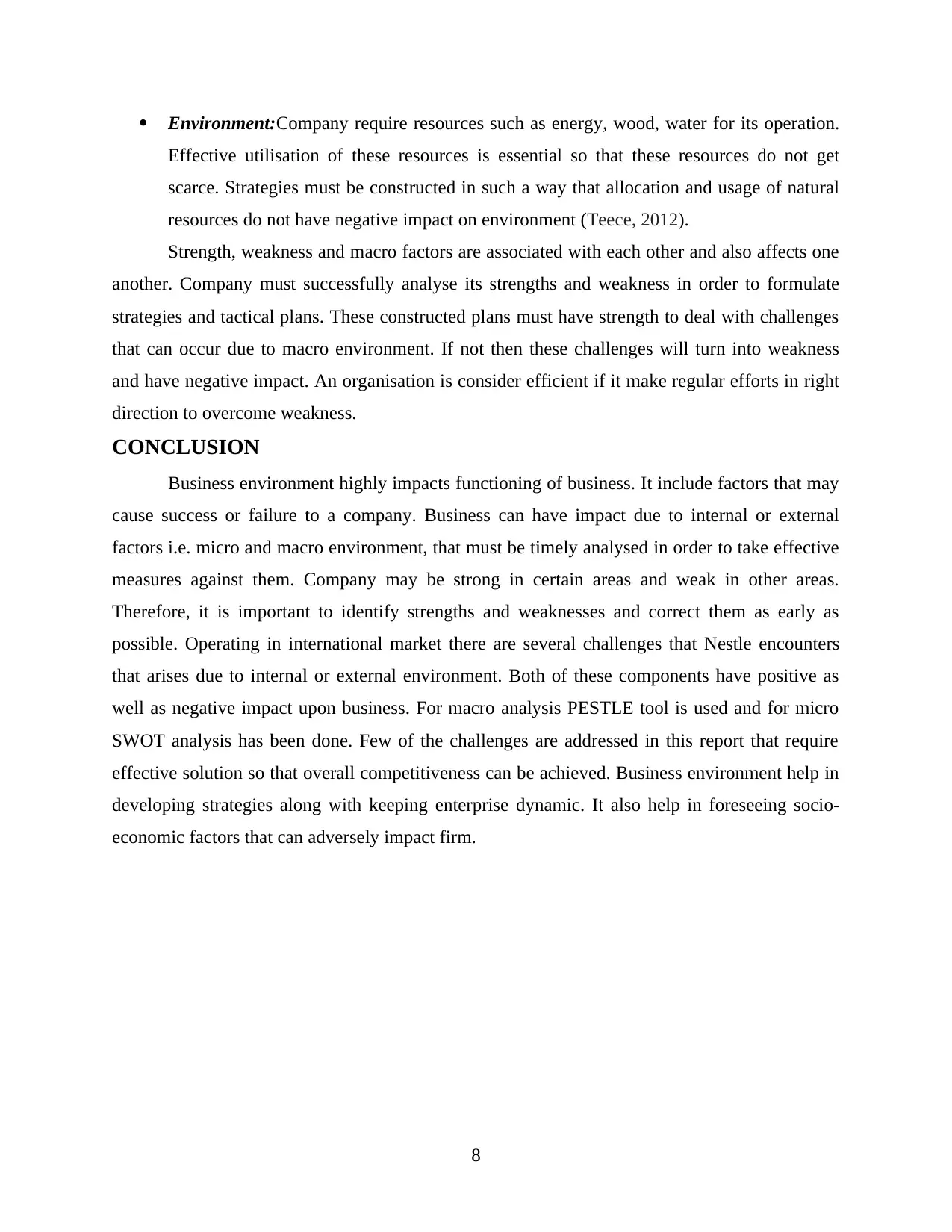
Environment:Company require resources such as energy, wood, water for its operation.
Effective utilisation of these resources is essential so that these resources do not get
scarce. Strategies must be constructed in such a way that allocation and usage of natural
resources do not have negative impact on environment (Teece, 2012).
Strength, weakness and macro factors are associated with each other and also affects one
another. Company must successfully analyse its strengths and weakness in order to formulate
strategies and tactical plans. These constructed plans must have strength to deal with challenges
that can occur due to macro environment. If not then these challenges will turn into weakness
and have negative impact. An organisation is consider efficient if it make regular efforts in right
direction to overcome weakness.
CONCLUSION
Business environment highly impacts functioning of business. It include factors that may
cause success or failure to a company. Business can have impact due to internal or external
factors i.e. micro and macro environment, that must be timely analysed in order to take effective
measures against them. Company may be strong in certain areas and weak in other areas.
Therefore, it is important to identify strengths and weaknesses and correct them as early as
possible. Operating in international market there are several challenges that Nestle encounters
that arises due to internal or external environment. Both of these components have positive as
well as negative impact upon business. For macro analysis PESTLE tool is used and for micro
SWOT analysis has been done. Few of the challenges are addressed in this report that require
effective solution so that overall competitiveness can be achieved. Business environment help in
developing strategies along with keeping enterprise dynamic. It also help in foreseeing socio-
economic factors that can adversely impact firm.
8
Effective utilisation of these resources is essential so that these resources do not get
scarce. Strategies must be constructed in such a way that allocation and usage of natural
resources do not have negative impact on environment (Teece, 2012).
Strength, weakness and macro factors are associated with each other and also affects one
another. Company must successfully analyse its strengths and weakness in order to formulate
strategies and tactical plans. These constructed plans must have strength to deal with challenges
that can occur due to macro environment. If not then these challenges will turn into weakness
and have negative impact. An organisation is consider efficient if it make regular efforts in right
direction to overcome weakness.
CONCLUSION
Business environment highly impacts functioning of business. It include factors that may
cause success or failure to a company. Business can have impact due to internal or external
factors i.e. micro and macro environment, that must be timely analysed in order to take effective
measures against them. Company may be strong in certain areas and weak in other areas.
Therefore, it is important to identify strengths and weaknesses and correct them as early as
possible. Operating in international market there are several challenges that Nestle encounters
that arises due to internal or external environment. Both of these components have positive as
well as negative impact upon business. For macro analysis PESTLE tool is used and for micro
SWOT analysis has been done. Few of the challenges are addressed in this report that require
effective solution so that overall competitiveness can be achieved. Business environment help in
developing strategies along with keeping enterprise dynamic. It also help in foreseeing socio-
economic factors that can adversely impact firm.
8
Paraphrase This Document
Need a fresh take? Get an instant paraphrase of this document with our AI Paraphraser
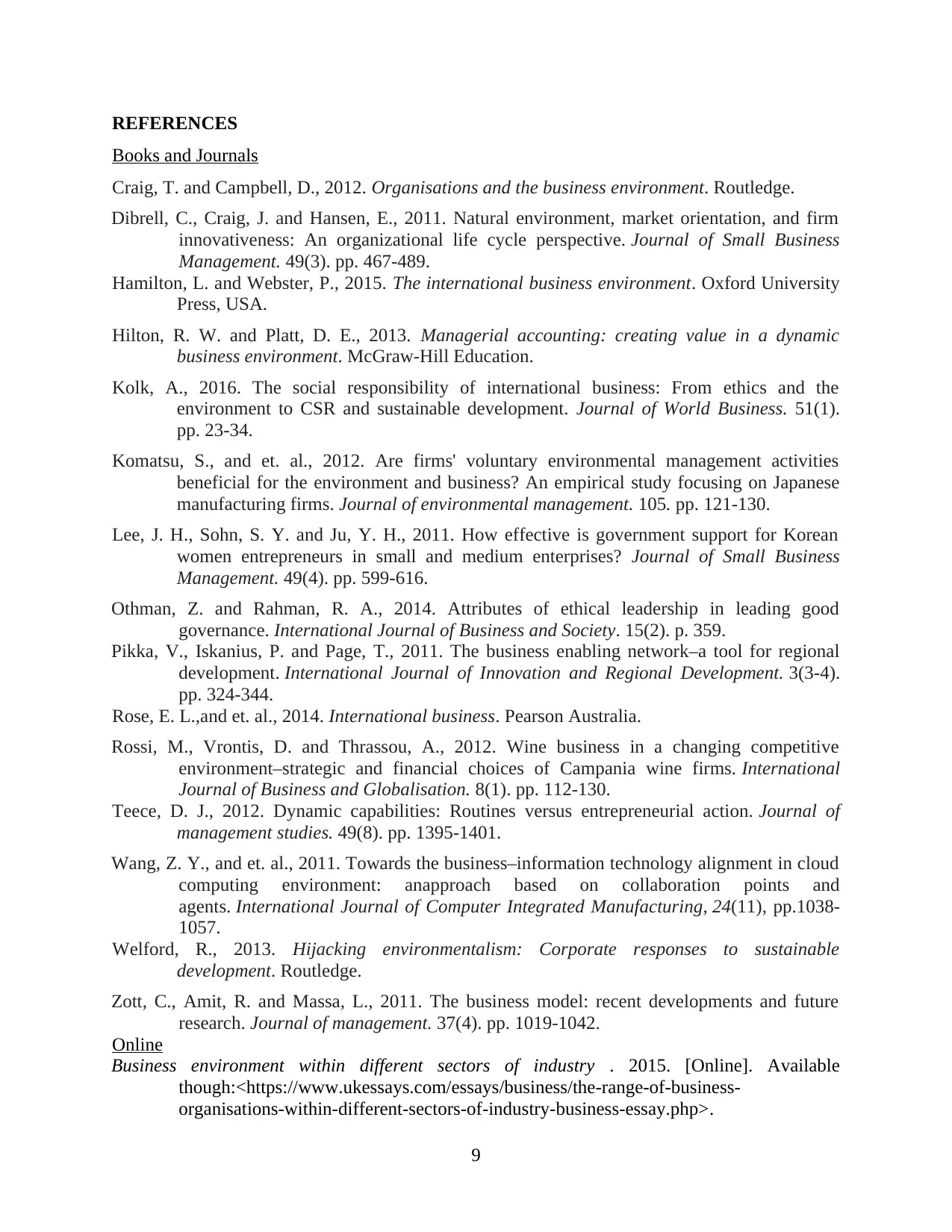
REFERENCES
Books and Journals
Craig, T. and Campbell, D., 2012. Organisations and the business environment. Routledge.
Dibrell, C., Craig, J. and Hansen, E., 2011. Natural environment, market orientation, and firm
innovativeness: An organizational life cycle perspective. Journal of Small Business
Management. 49(3). pp. 467-489.
Hamilton, L. and Webster, P., 2015. The international business environment. Oxford University
Press, USA.
Hilton, R. W. and Platt, D. E., 2013. Managerial accounting: creating value in a dynamic
business environment. McGraw-Hill Education.
Kolk, A., 2016. The social responsibility of international business: From ethics and the
environment to CSR and sustainable development. Journal of World Business. 51(1).
pp. 23-34.
Komatsu, S., and et. al., 2012. Are firms' voluntary environmental management activities
beneficial for the environment and business? An empirical study focusing on Japanese
manufacturing firms. Journal of environmental management. 105. pp. 121-130.
Lee, J. H., Sohn, S. Y. and Ju, Y. H., 2011. How effective is government support for Korean
women entrepreneurs in small and medium enterprises? Journal of Small Business
Management. 49(4). pp. 599-616.
Othman, Z. and Rahman, R. A., 2014. Attributes of ethical leadership in leading good
governance. International Journal of Business and Society. 15(2). p. 359.
Pikka, V., Iskanius, P. and Page, T., 2011. The business enabling network–a tool for regional
development. International Journal of Innovation and Regional Development. 3(3-4).
pp. 324-344.
Rose, E. L.,and et. al., 2014. International business. Pearson Australia.
Rossi, M., Vrontis, D. and Thrassou, A., 2012. Wine business in a changing competitive
environment–strategic and financial choices of Campania wine firms. International
Journal of Business and Globalisation. 8(1). pp. 112-130.
Teece, D. J., 2012. Dynamic capabilities: Routines versus entrepreneurial action. Journal of
management studies. 49(8). pp. 1395-1401.
Wang, Z. Y., and et. al., 2011. Towards the business–information technology alignment in cloud
computing environment: anapproach based on collaboration points and
agents. International Journal of Computer Integrated Manufacturing, 24(11), pp.1038-
1057.
Welford, R., 2013. Hijacking environmentalism: Corporate responses to sustainable
development. Routledge.
Zott, C., Amit, R. and Massa, L., 2011. The business model: recent developments and future
research. Journal of management. 37(4). pp. 1019-1042.
Online
Business environment within different sectors of industry . 2015. [Online]. Available
though:<https://www.ukessays.com/essays/business/the-range-of-business-
organisations-within-different-sectors-of-industry-business-essay.php>.
9
Books and Journals
Craig, T. and Campbell, D., 2012. Organisations and the business environment. Routledge.
Dibrell, C., Craig, J. and Hansen, E., 2011. Natural environment, market orientation, and firm
innovativeness: An organizational life cycle perspective. Journal of Small Business
Management. 49(3). pp. 467-489.
Hamilton, L. and Webster, P., 2015. The international business environment. Oxford University
Press, USA.
Hilton, R. W. and Platt, D. E., 2013. Managerial accounting: creating value in a dynamic
business environment. McGraw-Hill Education.
Kolk, A., 2016. The social responsibility of international business: From ethics and the
environment to CSR and sustainable development. Journal of World Business. 51(1).
pp. 23-34.
Komatsu, S., and et. al., 2012. Are firms' voluntary environmental management activities
beneficial for the environment and business? An empirical study focusing on Japanese
manufacturing firms. Journal of environmental management. 105. pp. 121-130.
Lee, J. H., Sohn, S. Y. and Ju, Y. H., 2011. How effective is government support for Korean
women entrepreneurs in small and medium enterprises? Journal of Small Business
Management. 49(4). pp. 599-616.
Othman, Z. and Rahman, R. A., 2014. Attributes of ethical leadership in leading good
governance. International Journal of Business and Society. 15(2). p. 359.
Pikka, V., Iskanius, P. and Page, T., 2011. The business enabling network–a tool for regional
development. International Journal of Innovation and Regional Development. 3(3-4).
pp. 324-344.
Rose, E. L.,and et. al., 2014. International business. Pearson Australia.
Rossi, M., Vrontis, D. and Thrassou, A., 2012. Wine business in a changing competitive
environment–strategic and financial choices of Campania wine firms. International
Journal of Business and Globalisation. 8(1). pp. 112-130.
Teece, D. J., 2012. Dynamic capabilities: Routines versus entrepreneurial action. Journal of
management studies. 49(8). pp. 1395-1401.
Wang, Z. Y., and et. al., 2011. Towards the business–information technology alignment in cloud
computing environment: anapproach based on collaboration points and
agents. International Journal of Computer Integrated Manufacturing, 24(11), pp.1038-
1057.
Welford, R., 2013. Hijacking environmentalism: Corporate responses to sustainable
development. Routledge.
Zott, C., Amit, R. and Massa, L., 2011. The business model: recent developments and future
research. Journal of management. 37(4). pp. 1019-1042.
Online
Business environment within different sectors of industry . 2015. [Online]. Available
though:<https://www.ukessays.com/essays/business/the-range-of-business-
organisations-within-different-sectors-of-industry-business-essay.php>.
9
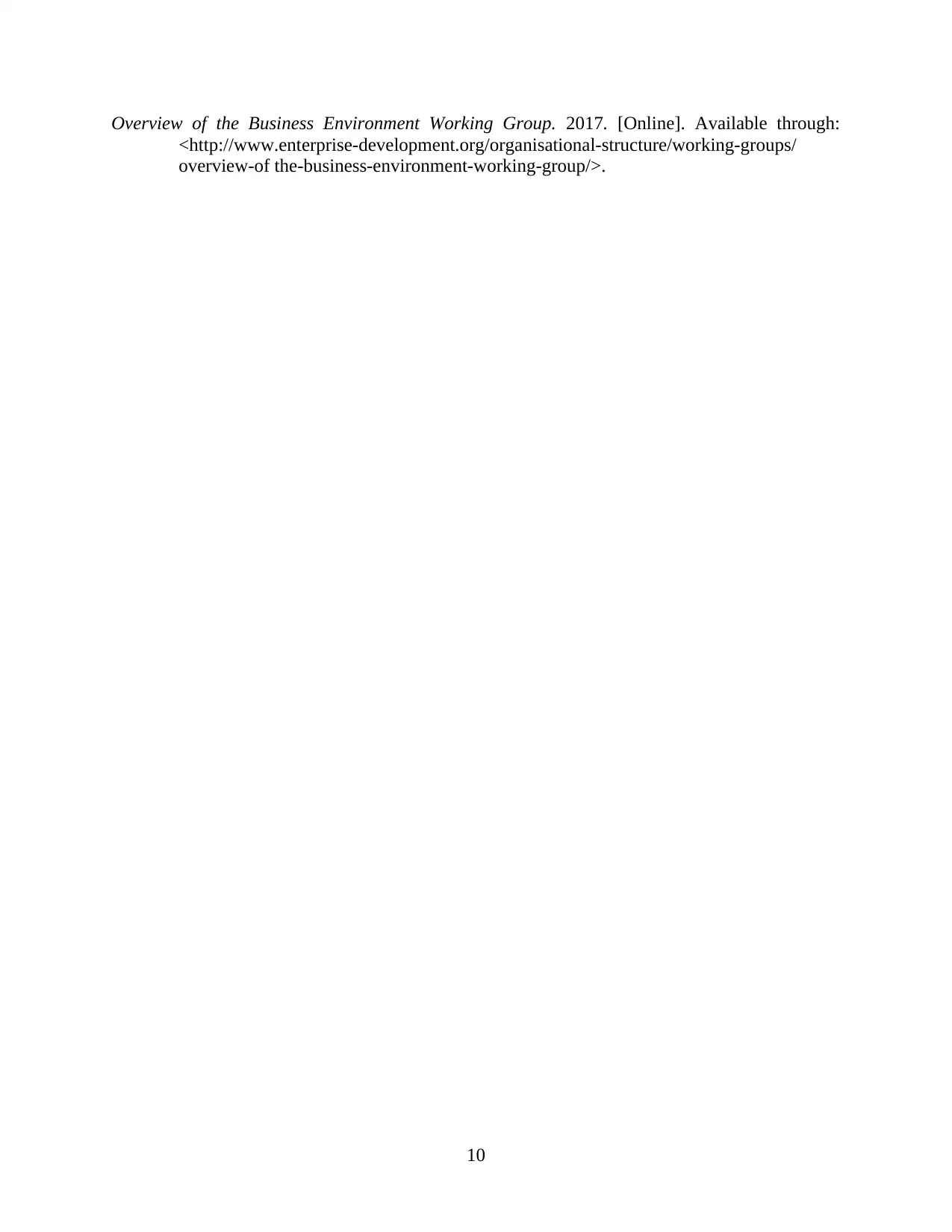
Overview of the Business Environment Working Group. 2017. [Online]. Available through:
<http://www.enterprise-development.org/organisational-structure/working-groups/
overview-of the-business-environment-working-group/>.
10
<http://www.enterprise-development.org/organisational-structure/working-groups/
overview-of the-business-environment-working-group/>.
10
⊘ This is a preview!⊘
Do you want full access?
Subscribe today to unlock all pages.

Trusted by 1+ million students worldwide
1 out of 12
Related Documents
Your All-in-One AI-Powered Toolkit for Academic Success.
+13062052269
info@desklib.com
Available 24*7 on WhatsApp / Email
![[object Object]](/_next/static/media/star-bottom.7253800d.svg)
Unlock your academic potential
Copyright © 2020–2025 A2Z Services. All Rights Reserved. Developed and managed by ZUCOL.





